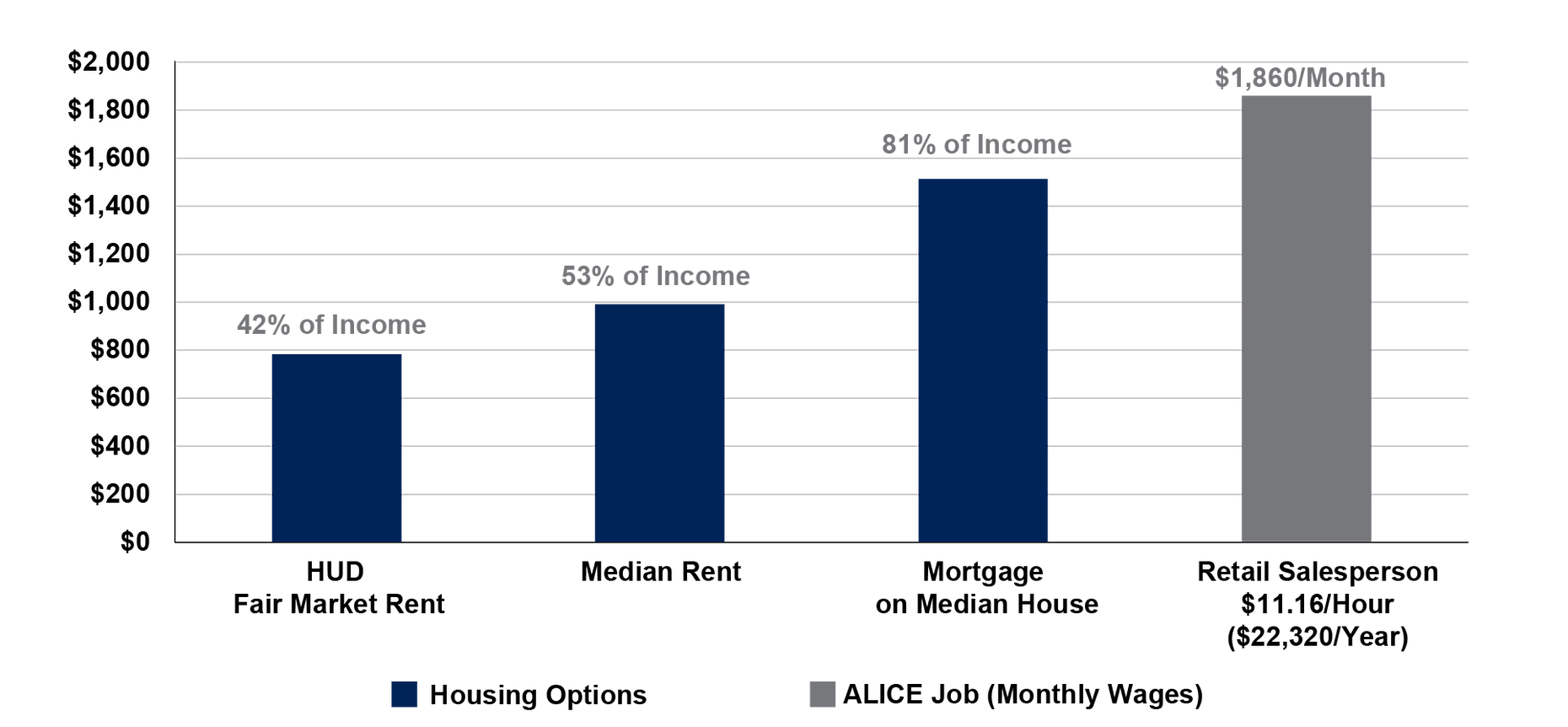
|
Housingclick to view |

|
Health Careclick to view |

|
Child Care and Educationclick to view |

|
Technologyclick to view |

|
Foodclick to view |

|
Taxesclick to view |

|
Transportationclick to view |
||
Introduction
Where we live matters, impacting financial stability, current and future health and life expectancy, exposure to violence, access to resources, housing and transportation costs, educational opportunities, and future economic prosperity.1 Yet ALICE families — whether they are homeowners or renters — are challenged to find affordable units and often spend a disproportionate amount of their income on housing. As a result, they are frequently forced to make difficult choices or sacrifices in other areas of their lives. Homelessness is the worst possible outcome when ALICE cannot afford basic housing, but there are less drastic consequences that also take a toll.
In 66 percent of U.S. housing markets in 2017, owning a home was more affordable than renting in the long term.2 Yet the cost of a mortgage and down payment, maintenance, and real estate taxes makes home ownership out of reach for many ALICE families. This is especially true for households of color, due to racial and ethnic discrimination in home buying and mortgage qualification practices.3
The relationship between the cost of housing and what an ALICE worker earns is shown in the figure below. The figure compares three different monthly housing options for a family of four to the monthly salary of a full-time employee working in retail sales.5 Retail sales is the most common occupation in the U.S. — more than 8.7 million jobs with an average hourly wage of $11.16, or $22,320 annually.
Monthly Housing Costs and ALICE Worker Wage, 2017

Sources: American Community Survey. (2017). 1-, 3-, and 5-year estimates; Bureau of Labor Statistics. (2017). Occupational employment statistics. U.S. Department of Labor; U.S. Department of Housing and Urban Development. (2017). Fair market rents
Nationwide, there is a 7.2 million-unit shortage in affordable rental units for extremely low-income renters; there are only 35 affordable units for every 100 of these households.6
Sources
1
Robert Wood Johnson Foundation. (n.d.). Could where you live influence how long you live? Retrieved from https://www.rwjf.org/en/library/interactives/whereyouliveaffectshowlongyoulive.html
Tate, W. F. (2008). “Geography of opportunity”: Poverty, Place, and Educational Outcomes. Educational Researcher, 37(7), 397–411. Retrieved from https://journals.sagepub.com/doi/abs/10.3102/0013189X08326409?journalCode=edra
Chetty, R., Hendren, N., & Katz, L. F. (2015, August). The effects of exposure to better neighborhoods on children: New evidence from the Moving to Opportunity Experiment. Retrieved from http://scholar.harvard.edu/files/hendren/files/mto_paper.pdf
2
ATTOM Data Solutions. (2017). Buying more affordable than renting in 66 percent of U.S. housing market. Retrieved from https://www.attomdata.com/news/heat-maps/2017-rental-affordability-report/
3
Desmond, M. (2015, March). Unaffordable America: Poverty, housing, and eviction. Fast Focus (No. 22-2015). Institute for Research on Poverty, University of Wisconsin–Madison. Retrieved from http://scholar.harvard.edu/files/mdesmond/files/fastfocus2015.pdf
4
National Fair Housing Alliance. (n.d.). 2018 fair housing trends report. Retrieved from https://nationalfairhousing.org/2018-fair-housing-trends-report/
5
Bureau of Labor Statistics. (2017). Occupational employment statistics: May 2018 national occupational employment and wage estimates United States. U.S. Department of Labor. Retrieved from https://www.bls.gov/oes/current/oes_nat.htm#41-0000
U.S. Department of Housing and Urban Development. (2017). Fair market rents. Retrieved from https://www.huduser.gov/portal/datasets/fmr.html#2017
U.S. Department of Housing and Urban Development. (2017). 2017 50th percentile rents. Retrieved from https://www.huduser.gov/portal/datasets/50per.html#2017
American Community Survey. (2017). Financial characteristics for housing units with a mortgage. Retrieved from https://factfinder.census.gov/bkmk/table/1.0/en/ACS/17_1YR/S2506/0100000US
6
Aurand, A., Emmanuel, D., Yentel, D., Errico, E., & Pang, M. (2018). The gap: A shortage of affordable homes. National Low Income Housing Coalition. Retrieved from https://nlihc.org/sites/default/files/gap/Gap-Report_2018.pdf

